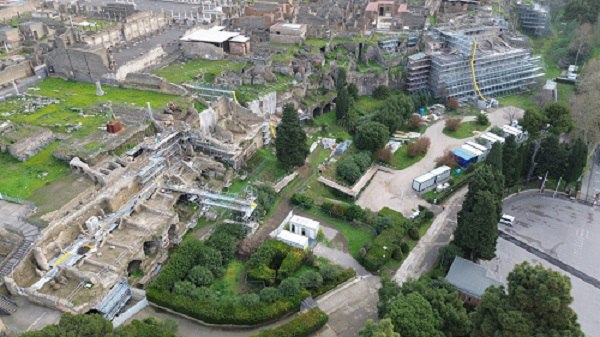Pompeii was reoccupied after the destruction of AD 79 New traces of the building site of the Insula Meridionalis are coming to light
“The data demonstrates that life continued after the catastrophe,
although such evidence had been ignored in previous excavations: this deleted part of history needs to be retrieved.”
Pompeii was reoccupied after the eruption of AD 79. Survivors who had no other means of starting a new life elsewhere, but probably even homeless people from other places, in search of a place to live and in the hope of finding valuable items in the rubble, had tried to re-occupy the area devastated by the volcanic eruption. This precarious, disorganised situation, which led to the re-emergence of traces of life in the city of Pompei, continued until the fifth century AD when the area was completely abandoned.
These hypotheses, already postulated in the past, appear to be confirmed by the data and traces that have emerged as part of the work to “safeguard, restore and consolidate the Insula Meridionalis of Pompeii”. Published in the E-Journal of the Pompeii excavations https://pompeiisites.org/e-journal-degli-scavi-di-pompei/, the evidence suggests that people returned to the site of the disaster and, at a certain point, began to live on a stable basis among the ruins of the upper floors that had re-emerged from the ash. Life therefore returned to the houses and structures, but the rooms that had originally been on the ground floor now became cellars and hovels where hearths, ovens and mills were established.
It is estimated that Pompeii had a population of at least 20,000 inhabitants in AD 79, but the percentage of people who lost their lives during the eruption is still the subject of considerable debate. About 1300 victims have been found since the beginning of the excavations in 1748 until the present. Given that two thirds of the city have been unearthed, the number might seem to be relatively small, the equivalent of about 10%. Many more may have lost their lives outside the centre of the city, as they were trying to escape from the epicentre of the catastrophe. There were definitely survivors, as is also shown by inscriptions with Pompeian names in other towns in Campania. However, not everyone could afford to start a new life elsewhere. This may explain why some inhabitants returned to the devastated city where the upper floors of the buildings were still visible.
Other people who had nothing to lose may have also joined the former inhabitants. They must have initially lived in a kind of ashy desert but vegetation soon began to flourish there again.
Besides being a place to live, Pompeii also offered the opportunity to dig into the subsoil where valuable objects could be found, even though there was a chance of coming across the body of a victim in a state of decomposition.
This situation, which was somewhat improvised, not to mention anarchic, may explain why the emperor Titus sent two ex-consuls in the role of curatores Campaniae restituendae: as well as promoting the refoundation of Pompeii and Herculaneum, they had the task of looking after the property of people with no heirs and to give it to the “afflicted towns and cities”. However, the attempt at re-founding the city proved to be a failure since the site never became the hive of activity it had been prior to the eruption. Instead, to judge from the archaeological evidence, there must have been a populated area where people lived in precarious conditions and without the infrastructure and services of a Roman city. This did not prevent a form of settlement from continuing until Late Antiquity - in other words the fifth century AD - when, perhaps after another devastating eruption (known as the ‘Pollena eruption’), the area was completely abandoned.
“The momentous eruption of the city in AD 79 has monopolised our memory”, commented Gabriel Zuchtriegel, the director of the site and co-author of the article on the new finds. “Amidst the enthusiasm of reaching the levels of AD 79, with remarkably well-preserved frescoes and furniture still intact, the fleeting traces of the re-occupation of the site were literally removed and often swept away without any records. As a result of the new excavations, the picture is becoming increasingly clear: a post-79 Pompeii is beginning to re-emerge. It was not so much a city as a precarious grey populated area, a kind of campsite with shacks sprouting up amongst the still recognisable ruins of the former city of Pompeii. In these cases, we archaeologists feel like psychologists of memory buried in the earth: we dig up the parts that have been removed from history, and this phenomenon should lead to a wider reflection on the archaeological unconscious, on everything that was removed or obliterated or remained hidden in the shadows of other things that were seemingly more important”.


